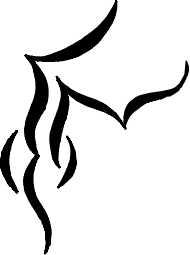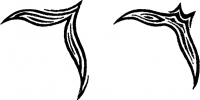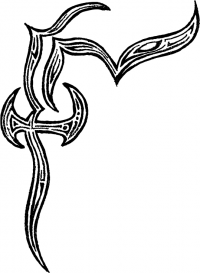Table of Contents
WARNING: The following material has not yet had a chance to become canonical.
Nayabaru are largely blind to the differences in their subcultures when they encounter them, as they tend to manifest on axes they are less interested in - this means there are no formal names for these subcultures, and this page will simply try to give them geographic names.
To better understand the degree to which these subcultures are 'blind' to each other, know that a Nayabaru themselves is likely to at most comment on the style of the tattoos or banners of a certain region, which may follow different ornamentation than their own.
In any case, some striking observations can be made about the subcultures.
Asheenagiji
Tain-Katal Coastal subculture
The most populous of the Nayabaru subcultures and one that can generally be given a kind of historic primacy, the Tain-Katal Coastal Nayabaru are the Nayabaru that live along the 'eastern' and 'southern' coastal stretches of Asheenagiji, the ends of which are loosely marked by Tain in the 'southwest' and Katal in the 'northeast'.
This subculture uses the tattoo alphabet with the visual design it was originally designed with, without adding inherent bells and whistles:

That said, the arrangement of the glyphs is still typically done with aesthetic intent. An example rendition of the title Hesh:

The Tain-Katal Coastal Nayabaru prefer to have the relevant words in large glyphs on their body, not repeated more than necessary, meaning that their tattoos tend to be up to several centimetres thick in stroke.
They are known to view kavkema that were not grown in their labs as creatures halfway suspended between 'animal' and 'terrorist', adopting the least flattering and/or more convenient traits of either. There is no room in Tain-Katal Coastal interpretation for any particular feeling of remorse toward the kavkema; they must be detained, and given that certainty, they might as well be made marginally useful.
The Tain-Katal Coastal subculture's scientific obsession can be said to be biochemistry, in that most of the notable biochemical substances (such as Serrata) can be traced back to this region. Especially prolific is Katal itself, which prides itself to be at the uncontested forefront of anti-kavkem efforts. Their experimentation is made possible by a moral footnote: They forgive accidental kavkem deaths.
Despite all this, the Tain-Katal Coastal subculture's ability to view kavkema as terrorists occasionally causes the minor miracle that the Nayabaru might accept a kavkem into their ranks, i.e. consider an individual kavkem a participant in their hierarchic structures, with responsibilities and obligations. Such an arrangement is rarely inherently stable - kavkema cannot be usefully tattooed without plucking them first, thus need to make do with banners to designate their profession and rank, which combines with their species to make Nayabaru inherently distrustful of their claims.
The subculture has been known to dabble with projects of raising Nayabaru-loyal kavkema, although they ultimately tend to sabotage their own efforts with their scepticism.
Reeva Peninsula subculture
The Reeva Peninsula subculture stretches across the entire 'peninsula' which Reeva is at the tip of and is bounded by the great Lakes in the 'east' - an area about as large as India - and reaches down to and slightly past Vortok, as well as laying claim to the scattered near-polar islands 'northwest' of Asheenagiji.
It can, from an outside perspective on the Nayabaru, be considered a radicalist subculture. While they are not under the same pressures as the Asheenagiji Desert subculture (see below) to be tolerant of deviants, they possess a similar principle. The Reeva Peninsula subculture has avenues for social redemption.
Since they do not consider social failing to be a permanent affliction, they are the most likely of the Nayabaru to talk to the kavkema, rather than simply antagonising them. That said, as with all Nayabaru, their social harmony overrides any interest they may have in 'forgiving' the kavkema, and any alliances should be considered exactly as temporary as they would elsewhere. They only happen to crop up more often.
Similarly, the Reeva Peninsula subculture is the source of Nayabaru without a title as a legitimate notion, having pioneered the concept.
All in all, they consider one's social place as far more mobile than the rest of the Nayabaru, though they would still be very confused by someone changing jobs more than once in their life.
In Reeva itself and select stretches of the landscape all the way up to Vortok, the tattoo system tends to keep the outline of the original glyph designs, but will occasionally fill them in with baubles rather than a solid colour:

Asheenagiji Desert subculture
The main body of the Asheenagiji continent is an arid expanse, home to vast stretches of desert. The Nayabaru scattered throughout this geographic region as well as the 'northern' coastal stretch loosely share a subculture. They are less likely to reject outcasts from other areas, granting them a richer but more dangerous cultural landscape. It has the highest murder rate, largely because it has the highest number of psychotic individuals (some of which are even selected to breed).
The Asheenagiji Desert subculture is notable in that it is the only subculture that will accept even accidental Nayabaru deaths - this ethical opinion is what has facilitated their ability to accept outcasts into their midsts in the first place. Deaths that have been ruled an accident by investigation are not punished at all.
This also implies that this subculture investigates crimes in an evidence-based manner - this is quite unusual, as the Nayabaru are usually happy to simply defer to the claims of the rank-highest Nayabaru that has as much as an opinion on the matter.
(Over many generations, their stance on accidental death has bled ever so slightly into the Tain-Katal Coastal subculture, who apply it exclusively to accidental kavkema deaths.)
The Asheenagiji Desert subculture itself has no general stance on the kavkema, given there aren't many kavkema amongst the wastelands. They are often driven back into the coastal areas if they are found, but they might just as well be captured and tortured purely for sport by the less savoury Nayabaru that have found refuge in this culture.
It's worth noting that not all Nayabaru outcasts that live in the area were necessarily accepted into any kind of community. Sometimes, all the Asheenagiji Desert subculture will do when faced with outcasts is to ignore them, as is true for any Nayabaru culture - though they may ignore them more gently than others and not send them away if they are unarmed and come to trade.
Asheenagiji Desert tattoo ornamentation is one of the only known to break up the outlines of the classic glyphs, instead winding wire patterns along the inside of the glyph's invisible confines. The exact ornamentation tends to vary strongly from region to region, taking on various details, such as occasional labyrinthine detail work. An example of the simplest form the ink wire might chart can be seen here:

Cetaros
The two island-continents the Nayabaru call Cetaros share certain cultural similarities that aren't observed anywhere else, although there is also a distinction between the islands. Together they are home to the second most populous Nayabaru subculture after the Tain-Katal Coastal subculture, although if one were to regard them separately, the Vatenas-Petraal subculture would outrank them both.
What the islands have in common is something humans might call 'a sense of pride' at their cultural achievements. They celebrate Nayabaru achievements, occasionally with simple rituals of everyday life. Their tattoos are the most strikingly ornamental on the entire planet, each glyph further containing or even accented by intricate tribal patterns:

An example rendition of the title Hesh:

Both Cetaros islands lean heavily toward the opinion that kavkema are animals (though they both grant them basic sapient 'protection' by their ethical system, i.e. consider their deaths something to prevent). Both have turned the art of hunting kavkema into a kind of sport - specifically, a test of skill and strategy with only minimal actual risk - although they draw different conclusions as to how to make this pleasure sustainable. This practise is one of the many manifestations of the 'celebration' idea; in this case, celebrating the supremacy of the Nayabaru over the kavkema.
Despite this practise, it's worth noting that they are not inherently crueller to captive kavkema than any other culture.
Valesh Island subculture
The area around Valesh, scattered pockets in mainland Cetaros, as well as some of the islands south of Cetaros (but not all of them) are home to a Nayabaru subculture that has a certain respect for kavkema, like one would of any formidable opponent or dangerous animal.
Despite the 'animal' designation, the Nayabaru of the Valesh Island subculture are considerably more interested in the kavkem culture than the rest of the Nayabaru culture would claim. There are informal areas that the kavkema are left alone (though no explicit mention of these may be made, lest the Nayabaru might have to do something about these areas) so that they won't die out, leaving enough available for the occasional hunt.
Occasionally their hunting practises involve catching kavkema and releasing them again later, simply to hunt them again.
Cetaros Main subculture
The rest of Cetaros leans more toward a mixture of the Valesh subculture and the Asheenagiji subculture. They do not fully share the Valesh subculture's habit of viewing kavkema as animals, inherently attributing some sapience to them, enough to consider them weakly accountable for their actions.
Rather than keep areas free of tampering as that they might always have kavkema to hunt, Cetaros Main follows a strict policy of trying to capture any wild kavkema, much like one would expect in Asheenagiji. However, they will occasionally release tagged kavkema (often ones bred in captivity, but occasionally previous captures deemed harmless enough) into the wild to facilitate a ceremonial hunt.
Vatenas
Vatenas-Petraal subculture
Nayabaru populations on Vatenas itself, as well as the city Petraal on the coast of Sefusa, form the Vatenas-Petraal subculture. This subculture comes as close to a true scientific mindset as a culture nonetheless steeped in tradition and community likely can be, taking special pride in the achievements of its Darhala.
They're a fairly purist subculture that does not tolerate much mixing with other subcultures (Petraal on Sefusa notwithstanding). Vatenas as a whole keeps itself neatly isolated from the other subcultures by nature of being an island. They keep communicative contact with the rest of the Nayabaru primarily so they can learn of new technologies.
The Vatenas-Petraal subculture considers the kavkema to be entirely sapient and fully accountable for their actions. While this greatly reduces the degree to which anyone in Vatenas might even consider using kavkema as lab rats, it's still an unforgiving place - every creature once killed by a captive kavkem will be held against the captive and the Nayabaru of course know that kavkema are preferentially carnivorous. The focus on kavkem incarceration is very much on containment and punishment.
On the other hand, occasionally, kavkema might redeem themselves - much like a human who was sentenced to a certain number of years of imprisonment to then walk free. Of course, containment is still a paramount, so freedom is not an option. However, the subculture is entirely willing to use kavkema as slaves (other cultures might call the same setup “pets”). Note that this arrangement is actually the most likely to treat kavkema kindly and a constellation bordering on friendship may form between a 'reformed' kavkem and its Nayabaru 'owner'. That said, these 'friendships' take time, the right personalities, and from a Nayabaru perspective it's clear that it must be earned with hard work and loyalty.
Vatenas tattoos tend to be minimalist, with thin strokes and accented joints that only hint at the original glyph joint design. Nonetheless, they are quite recognisable as tsha͡um or fega͡uri:

The Vatenas-Petraal subculture is known to prefer having what they consider to be strictly legible tattoos, using them more like they might regular writing, and repeat the tattoos as necessary to fill the necessary areas. An example rendition of the title Hesh, still heavily stylised by Vatenas-Petraal measures (the curves may end up straightened out arbitrarily, and the rotation of the glyphs is often adjusted so they 'share' a rotation, much as when they are taught):

This sequence of curves would be repeated several times on the back of the Hesh in question - once in very large lettering, then in smaller patterns visually grouping with the large tattoo (a bit like a tag cloud).
Tabraan
Tabraan is a very large, mountainous island. At one point in its past, this detail of its landscape allowed kavkema to thrive.
The Tabraan subculture Nayabaru are the only Nayabaru on Nekenalos known to be somewhat superstitious, ascribing near-metaphysical qualities to their nemesis. However, with these meta-physical qualities came a certain codex of behaviour, and the Tabraan Nayabaru were known to leave larger kavkem territories well alone, breaching them only when they themselves required the territory to establish a new community, or when the specific kavkema roaming the area had been rumoured to attack Nayabaru or their livestock.
As such, defensive measures tend to be fairly minimalist, and offensive measures very sweeping when applied.
Exceptions are generally made when kavkema are needed to study them, to find more effective means to combat them; the Tabraan subculture would not usually breed kavkema in captivity, unless they had reason to believe that it would be difficult to find another example of a genetic subtype in the wild (such as populations from the islands between Tabraan and Vatenas).
Unfortunately, the repeated application of sweeping offensives had left Tabraan almost barren of kavkema before the Tabraan pushback.
Tabraan tattoo glyphs are often only an outline, as though they were hollow:

Sefusa
Sefusa is a large stretch of land whose mountain ranges have been claimed by the Nayabaru more than on any other continent. The kavkema that live here tend not to be mountainous, instead hiding in the jungle that the Nayabaru have rejected as a habitat, but as it is not an environment they were made to thrive in and evolution has not quite pushed them far enough to fix this problem, there are not many kavkema on Sefusa at all.
Accordingly, kavkema are almost invisible to Sefusa. Indeed, some Sefusa subculture Nayabaru may live their entire life without encountering a kavkem or as much of a story of one, believing them to merely be monsters of old. Correspondingly, the Sefusa subculture is notable in that it does not engage in defensive measures against the kavkema more than would be necessary to keep out any other predator straying too close to their settlements.
Even in areas on Sefusa that are still convinced kavkema exist, such as the areas immediately around Petraal or Farden, where Pens are still common, the Sefusa subculture shows no inherent interest in abusing the kavkema as labrats or otherwise 'dehumanising' them. However, this should be attributed to disinterest, not to kindness.
The tattoos of the Sefusa subculture are usually rendered in an 'open' fashion, missing part of the glyph outline, but make up for this by emphasising the flow of the segments with additional strokes, most of which run aesthetically parallel to the remaining outline(s), such as here:

